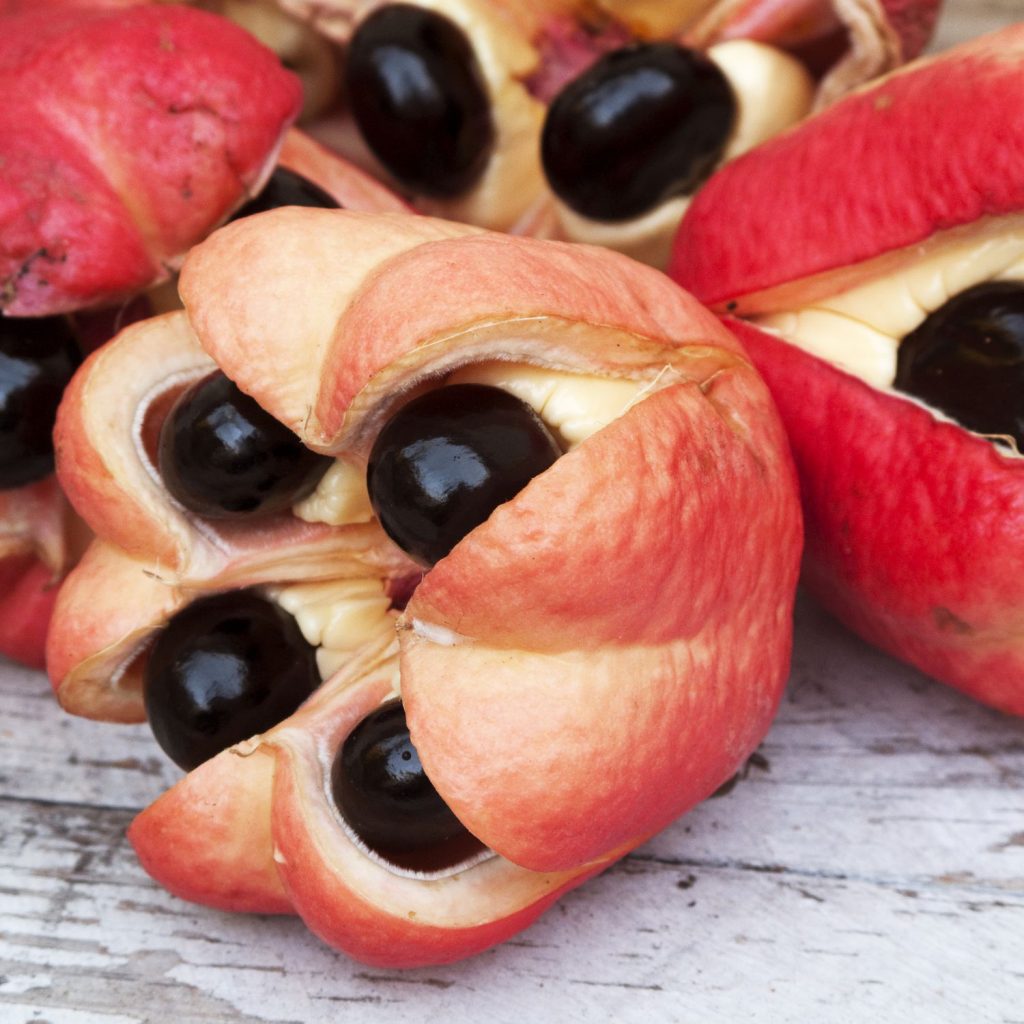
Ackee must be carefully harvested and prepared.
Delicious and deadly, that’s ackee.
Native to Africa and a common food in the Caribbean Islands Ackee is eaten at home and in restaurants in Jamaica and canned in brine for export. Because Ackee killed some 5,000 people between 1886 and 1950 the raw fruit is officially banned in the United States though you can buy it frozen or canned. I knew someone who had a tree in his yard. Like the tomato it’s a fruit that’s used like a vegetable and is the national dish of Jamaica.

Jamaican Ackee Pizza
You will find this tree either wild or intentionally cultivated in Central and South Florida. The toxin in the fruit is hypoglycin, an amino acid unnatural to our bodies. It causes a severe drop in blood glucose. The arils are toxic before the fruit naturally opens called “yawing.” The seeds are always toxic. If even a tiny little part of seeds are left in the ripe arils it can make you sick. The rind has saponin and is used to poison fish.
The botanical name Blighia sapida is name for Captain William Bligh of “Mutiny on the Bounty” notoriety. He got the nomenclature nod because he was the first one to take the plant to Kew Gardens in London in 1793. Sapida means savory, delicious or prudent and wise… a questionable name for this national fruit.
I’ve eaten Ackee once raw and it reminded me of cheese in flavor and texture. Indeed, there are four dozen cultivars and they are split between “butter” or “cheese” types. The “cheese” type is pale yellow and solid and often used in canning. The butter type is more delicate and more often used fresh.

All of Ackee is toxic except the ripe aril.
If we combine two reports we learn 100 grams of fresh ackee aril has 10 grams of carbohydrates, 3.45 grams of fiber, 19 grams of fat, 9 grams of protein and 140 calories. There’s 500 IU of vitamin A and 68 mg of vitamin C which is your daily need. Iron is 5.52 mg, calcium 30 mg, B1 (thiamin) 0.10 mg. B2 (riboflavin) 0.18 mg, and B3 (niacin) 3.74 mg.
A tall evergreen tree, most poisoning happen in the winter because the tree does not get enough sun exposure. If raised from a seed the tree can fruit in as little as three years.
Green Deane’s “Itemized” Plant Profile
IDENTIFICATION: Medium to large tree, 30 to 75 feet, alternate pinnate leaves with six to eight leaflets with short stems; shiny green, stiff, six to eight inches long.
ENVIRONMENT: Grows well in well-drained, deep, fertile soils but also non-fertile soils such as sand and calcerous bedrock
TIME OF YEAR: January March, October-November.
METHOD OF PREPARATION: The aril is edible only when the fruit naturally opens. It must be separated from the fruit and the seed and absolutely no part of the seed is consumed. The red tissue and veins that attach to the aril must be removed. The aril is edible raw and turns yellow when cooked. Don’t over cook as it will fall apart easily. You can get ill from canned fruit.

